BlackBerry Leap review: an old phone with a fresh face

Two years ago, BlackBerry finally broke free of the monotonous cycle it had entrenched itself in by launching its first all-touchscreen device, the Z10. Despite it being a costly flop, the company formerly known as RIM has continued to explore touchscreen territory with the help of its poke-friendly BB10 OS. BlackBerry is no longer a stranger to the form factor: It quickly followed up the Z10 with the Z30, and now the new BlackBerry Leap. There's little that separates BlackBerry's three main touchscreen devices as far as internals are concerned, and therein lies the main problem with the Leap. Instead of trying something different, BlackBerry has kept well within its comfort zone and pushed out another mid-range, touchscreen handset that's marginally divergent from its predecessors. Don't get me wrong: If a Leap lands on your desk to replace an old work phone, you'll no doubt get on with it just fine. But, if your own money is on the table, you're probably going to want to take it elsewhere.
Hardware
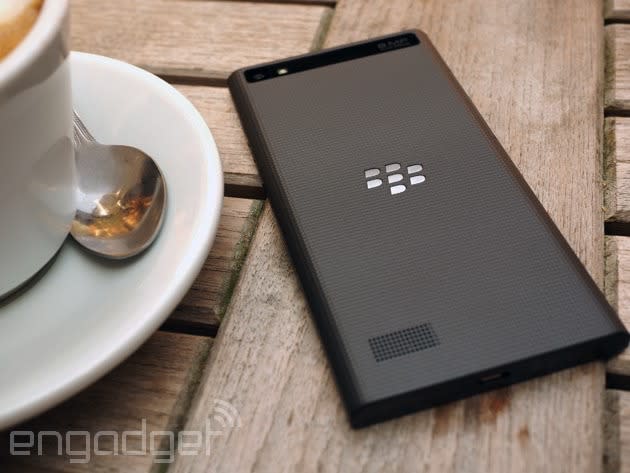
Let's be frank: BlackBerry isn't known for inspired design. The recent keyboard-toting Classic is almost an admission of that, it being a regression for the company; an homage to the Bold devices that found popularity many moons ago. Even the Porsche Design collaborations, the pocket-stretching Passport and the as-yet unreleased, curved-screen slider are all variations on a weary theme. That being said, the new Leap is at least a stark change from the two touchscreen BlackBerrys that came before it. The company isn't exactly breaking the mold, though: The Leap takes more than a few design cues from the BlackBerry Z3, a lower-end touchscreen device that has only been released in a few developing markets.
Distancing itself from the soft curves of the Z series, the Leap is a real blunt object of a phone. It's a black and gray slab with sharp corners, meant for serious business, and I can't help but find it lacking in character -- unless that character is a middle manager at a logistics conglomerate. There are positives and negatives to this "all work, no play" design. On the one hand, it looks and feels like you could hammer nails with it. That's to say it's solid as a rock, to the extent that the body won't flex or twist, even under considerable pressure. The build quality is admirable: All the parts fit together snugly, though the seams around the glass frontage are prone to trapping dust and lint. Also, the dimpled, rubbery material that covers most of the device feels like a built-in shock case, giving the impression that the handset can shrug off a fall or two.
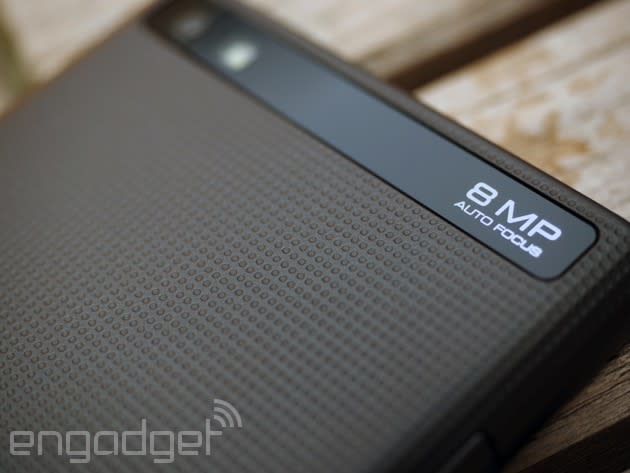
On the other hand, however, the Leap being a solid square block makes it a tad cumbersome in the hand. Sure, the dimpled back, with its slight curvature as it meets the sides, gives ample purchase and comfort; but, the device is tall, wide, thick and verging on heavy at 170g (six ounces). The Leap's 5-inch display is flanked on all sides by healthy bezels, and while my spidery hands didn't struggle to manipulate the device, my thumb was always leaning over dead space to get at the screen. I was constantly shifting my hand position so my thumb could reach the edges of the display, primarily because the BlackBerry 10 OS is centered around several swiping gestures that have to start off-screen. This serves to reinforce the feeling that the Leap is huge for a 5-inch device; the power button's central placement on the top edge next to the headphone jack doesn't help much either.
The volume rocker -- or rather, the two volume keys on either side of the BlackBerry Assistant button -- is more sensibly placed toward the top of the right edge, and the micro-USB port is exactly where you'd expect at the base of the device. Since the Leap's back panel is fixed (the battery is nonremovable), the micro-SIM and microSD slots are hidden behind a panel on the left edge. Beyond the usual buttons and holes, BlackBerry's added some subtle accents here and there. The back has an industrial look to it, with the dimpled gray canvas highlighted by a square, punched-out loudspeaker grille, sunken silver BlackBerry logo and glass band covering the camera lens, announcing its specifications in futuristic font. The front-facing camera and earpiece are joined by a large, red notification LED on the face of the device that screams, "Check your phone," and another silver BlackBerry logo (this time with the name alongside it) sits below the display.
None of these are unwelcome touches, but they don't combine to make the Leap anything more than indistinctive. If the handset didn't feel so big, the grand design might blend better with the utilitarian nature of the device. But, being a little awkward to use with one hand, it doesn't seem like a more striking look was sacrificed in the pursuit of enhanced productivity.
Display
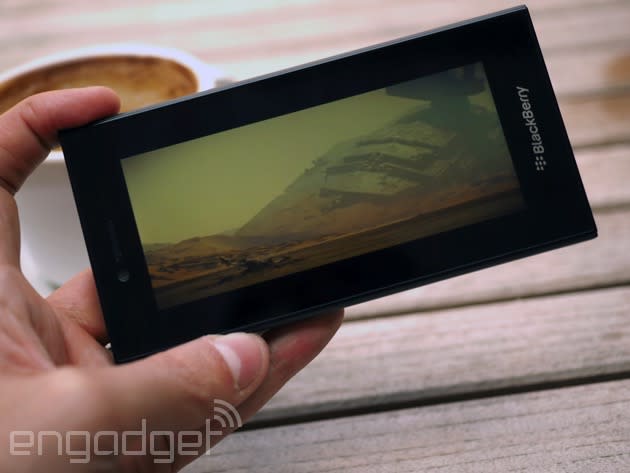
The Leap has a 5-inch, 1,280 x 720 (720p) LCD display, which is nothing abnormal for a mid-range device at this price point. (In fact, I would be surprised if the numbers were any different). I'm not a great believer in huge pixel counts making a massive difference to user experience on small screens, but I appreciate a good quality panel. Alas, the Leap's display left me wanting. Colors are vibrant enough and the white balance setting spot on, although you can adjust this in the settings if you feel otherwise. Blacks are of the depth typical to LCD displays, which is to say good, but not as vacuous as you see with AMOLED technology. When I'm on a particularly dark screen, I can pick out areas along the perimeter where light is bleeding onto the display. My review unit's screen is particularly ill-fitting in the top left-hand corner, although the uneven lighting is barely noticeable with brighter colors.
Viewing angles are passable, but sunlight readability is where it really lets itself down. The display's lacking the kind of power you need to cut through direct rays, and there appears to be no difference between 50 percent brightness and full whack when the sun's beating down on the glass. It's not completely unreadable -- you'll still be able to follow a map, read a tweet or just about frame that picture through the glare -- but it's just not enjoyable having to squint and spin around in search of the shade of your own shadow.
Software
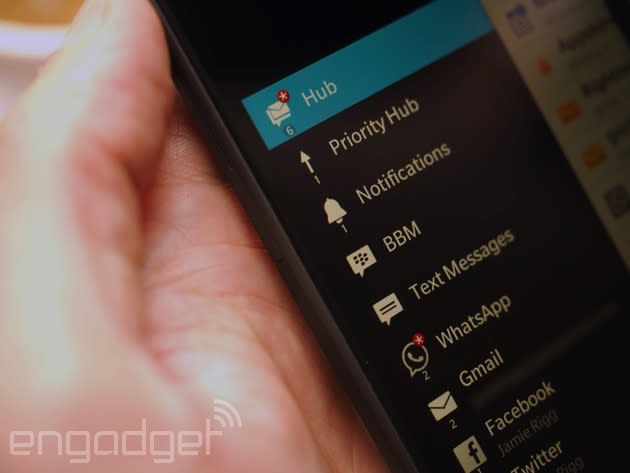
The Leap runs BlackBerry 10. Build 10.3.1 of the OS, to be exact, like the BlackBerry Classic. Even if you've had no prior experience with BB10, you should find it vaguely familiar all the same, although it relies more heavily on gestures than other mobile operating systems. You'll see a plain home screen when you unlock the device; a swipe to the left will bring up your app grid. Gesturing becomes important when you're actually running an app, and swiping up from the bottom bezel will effectively minimize what you're looking at and pin it to the home screen, which doubles as your task manager. It means you can quickly get at your most used apps and see what's running in the background. And kinda like Windows Phone's Live Tiles, some display snippets of live information -- your last WhatsApp IM, for example. Swiping right in some apps brings up contextual menus, and swiping down from the top bezel anywhere within the OS will give you access to a quick-settings dropdown. In short, it'll be relatively intuitive to anyone who's handled a smartphone before, and you quickly get used to the emphasis on gestures.
From the home screen, swiping right sends you to the BlackBerry Hub, one of the key features of BB10. It's probably best described as an email client/persistent notification bar (or maybe not). By far my favorite thing about the OS, it puts all of your messages and notifications in one place, from texts, emails, tweets and IMs to Facebook pokes, your call history, calendar appointments and low-battery reminders. You can filter, prioritize and view notifications from individual services and accounts, of course, but it's nice to have everything within thumb's reach. I can dismiss a missed call, mark a WhatsApp message as read, delete an SMS, archive an email and jump straight into Facebook to check the photo I've been tagged in right from the Hub. Being a Gmail user almost exclusively, I wish I could tag and archive emails easier, without having to go through a bunch of menus, but even I find the BlackBerry Hub extremely... productive, dare I say it.
I guess you could consider the BlackBerry Assistant another main feature of BB10, especially since it has its own dedicated physical button in between the volume keys. It's basically BlackBerry's version of Siri, Cortana or Google Now. You can instruct the voice-controlled virtual assistant to change settings, launch apps, message a friend, find you a dinner spot, perform contextual searches of content on the device or the web and so on. I can't say there's anything extra-special about this particular manifestation of a virtual aide, although it did easily answer my question of "How much wood would a woodchuck chuck if a woodchuck could chuck wood?" What it does, it does well, even if you have to wait a couple of seconds for it to process requests. As with its peers on other platforms, though, I just don't find myself using BlackBerry Assistant. I'd rather tap at my phone than talk to it. And let's be honest: So would you.

A feature introduced in BB 10.3 that definitely deserves an extended mention is BlackBerry Blend. Install the Blend client on your PC or Android/iOS tablet, pair it with a BlackBerry and you can access that phone from anywhere. Within Blend, you'll find your contact list and calendar appointments, as well as a lighter version of the BlackBerry Hub comprising emails, text messages and BBMs. In addition to being able to view this information, you can also add calendar appointments and send messages from the client without touching your phone. For enterprise users, it means you can hammer out a few work emails on your home computer without logging into a corporate VPN, or see your next meeting and text your co-worker to tell them you'll be late if you've left your phone on the kitchen table.
It's not seamless or elegant in the way Apple's Continuity feature works between iOS and OS X, and you can't dial out or even see your call history within Blend. But, it's a simple, unashamedly functional app. I can't claim to have used it extensively, but being able to access all data on the phone from the comfort of my laptop made transferring my camera sample photos a breeze. So, even if you're not a business type, there are still tasks that Blend can simplify for you.
Since the Leap is one of a handful of BlackBerrys without a physical keyboard, it's worth noting that the typing experience is still fantastic, and as good as you'll find on any touchscreen smartphone. BlackBerry uses a type of predictive-text engine that suggests a couple of words you might be working toward above what would be the next letter in that word. You can lock in predictions by swiping upward on the letter below, but I found paying attention to these only slowed me down. Regardless, I can still crank out prose at a rapid pace by letting the prediction engine do its thing without my input, and for me, it's almost as good as SwiftKey, which is the first thing I install on every Android phone I get my hands on.
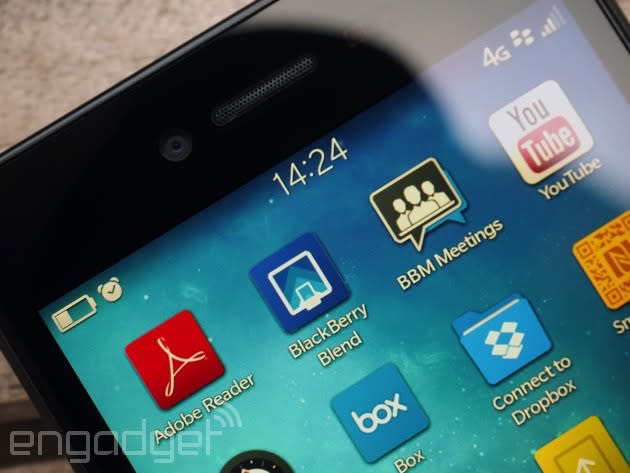
There's a lot to like about BB10 and yet, it still feels like it's lagging behind the major platforms. And that's not strictly about app availability either. The Maps application, for example, just isn't as pretty or as slick as Google's offering. Similarly, the stock browser lacks polish, and other core experiences aren't as user-friendly as their competitors. Setting an alarm takes far too many taps, and various menus are unnecessarily complex. The app selection, too, is a problem for me, and I must confess to carrying around a secondary Android handset while using the Leap as my daily driver. You have access to apps from BlackBerry World, which is pitched as the place to go for productivity tools, and Amazon's Android Appstore, which contains a bit of everything. Still, the range of apps available through both of these combined is nothing compared to Google Play or Apple's equivalent.
The preinstalled YouTube app, for instance, is a link to the mobile site, and there's no official Instagram client in either app store, let alone all the obscure Android apps I use regularly. You can sideload Android apps if you have the inclination and the know-how, but that's no real solution to app scarcity -- plus you have to manually update any sideloaded apps when new versions are released. It's the same criticism of BB10 (and Windows Phone, for that matter) you hear time and time again. Now, if you're supplied a Leap as a work phone, you're probably not going to care all that much about filling it with apps. But, if you're looking at one for yourself, a weak app selection might be cause for concern.
Camera

Like the Z10 and Z30, the Leap sports a modest 8-megapixel camera, with a 2-megapixel front-facing shooter for all your selfie and video-calling needs. Considering the Leap is really an enterprise device that's geared toward productivity, not taking pretty pictures, its primary camera is surprisingly versatile. The stock camera interface is nice and light, just how I like it, with only a handful of settings. From the viewfinder menu, you can change flash behavior; aspect ratio; turn HDR on/off; set a timer; and select among normal, panorama, burst-capture and time-shift shooting modes (the latter is basically burst capture, but you pick your favorite image to keep). There's no messing around with ISO values, exposure compensation and white balance settings: All of this is handled automatically. One thing that's missing and shouldn't be, however, is the option to turn off the irritating shutter sound.
The stock camera app has one particularly neat feature I paid close attention to. It suggests certain settings and modes based on what it sees through the lens, like recommending HDR mode if it detects contrasting lighting, or burst capture if it spots a face in the shot. I accept these suggestions more often that I reject them, finding that I tend to get the best results if I follow the camera app's advice.
Like all cameras, the Leap's main shooter does its best work in favorable lighting conditions. Robust auto-exposure compensation makes for well-saturated snaps, and even when artificial light is at play, the phone is a good judge of white balance. Shutter lag is almost nonexistent, and I'm particularly fond of the HDR mode, which adds a bunch of extra depth to photos when used appropriately. It's no use when the light starts fading, however, as the gap between the three shots it takes to build the HDR image lengthens and you end up with a blurry picture that looks like an impressionist painting. In the twilight hours, the camera struggles to pick the appropriate settings. Pictures are either under- or overexposed more often than not, but it settles down when nighttime truly rolls around and it can show off its admirable low-light performance. It certainly doesn't give up when light is at a premium, nor does it crank up exposure to the degree that images appear flat and overly noisy.
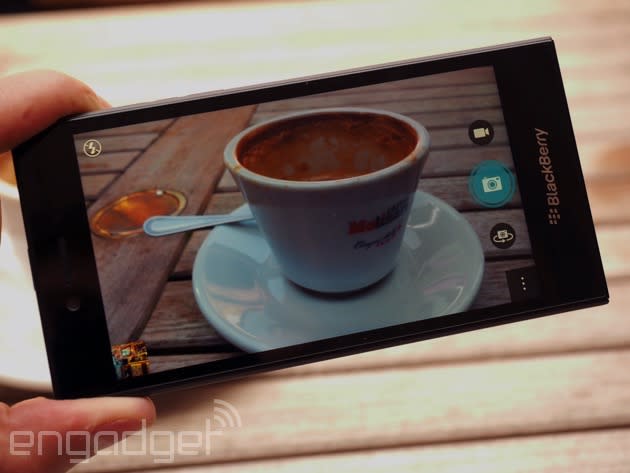
It's not all gravy, however, as focusing can be a bit problematic. Half the time, the camera locks in almost instantly on whatever you're pointing it at, but other times it's prone to inexplicably darting around, searching for the correct depth. It's not the best camera for shooting in the macro range, either. The closer an object is to the lens, the less likely you are to be able to get it in focus. Strangely, continuous autofocus when recording 1080p video works dreamily. It hardly ever fidgets, instead transitioning smoothly from one focal point to another. Video quality in general (and accompanying audio) is pretty outstanding. A high frame rate is maintained regardless of how much you're moving around, and like continuous autofocus, the exposure and white balance settings are similarly stable. Clip quality drops substantially in low light, becoming horribly noisy, but that's understandable when stills are much easier to process.
The Leap's 8-megapixel camera is no substitute for a proper DSLR, of course, but it's more than capable of taking great-looking shots when the opportunity strikes. In fact, it's among the best smartphone cameras of this caliber I've ever used, so kudos to BlackBerry for that.
Performance and battery life
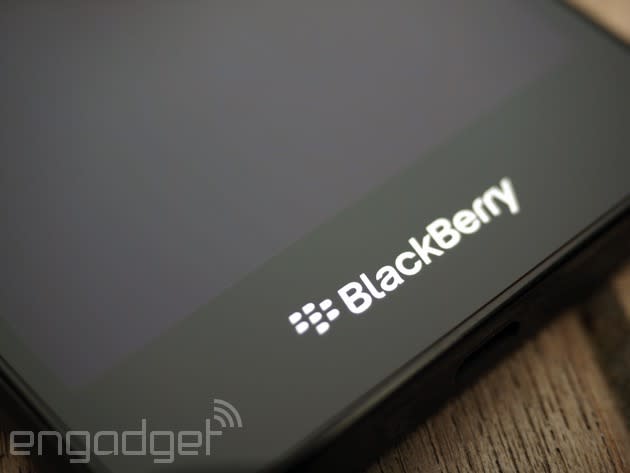
Inside, the Leap shares exactly the same internals as the two-year-old Z10: a 1.5GHz dual-core Snapdragon S4 Plus chip, 2GB of RAM and 16GB of internal storage (the Leap takes microSD cards of up to 128GB, too). The Z30 is practically the same, albeit with a slightly faster 1.7GHz dual-core S4 Pro processor. Just because the Leap is the newest member of the family doesn't mean it needs to have the best raw specs, but that S4 Plus chip is a red flag. It's ancient, at least in silicon years. Even so, it hums along nicely in the Leap, and I can't really complain about everyday performance. That said, I can't shake the feeling consumers are being short-changed somewhat by the presence of this last-gen processor.
BB10 is quite animation-heavy. Whether you're minimizing an app to the home screen, swiping across to get to the Hub or dragging the quick-settings menu into existence, there are always elements that are appearing while others are disappearing. If you move slowly through the app drawer, for instance, you'll see a subtle transparency effect applied while one grid is in the process of usurping the other. There's a lot going on, and nothing immediately opens or closes; it transitions. The point I'm trying to make is: I'd assume the phone has a lot to process while all this is happening, but even with several apps running in the background, the Leap doesn't miss a beat.
You can fly around the device pretty much as fast as your fingers can take you, only having to pause for a second while your chosen app or message loads. Browser performance is as slick as you need it to be, too. Pages load rapidly and you'll only stumble across the odd desktop site where tiling is visible. So, the chipset might be antiquated, but it doesn't have a significant impact on user experience. Occasionally, the phone does exhibit the odd glitch. An app will hang for a split second longer than usual, or there'll be a slight pause in between tapping a text-entry box and the keyboard appearing. Other times, the phone simply ignores a tap or a gesture, but I'm not sure whether this has to do with performance hiccups or quirks in the OS.

Gaming performance doesn't leave much to be desired, either. Not having access to my favorite Google Play titles, and not seeing much in the BlackBerry World store, I've sought out graphically intensive games available on Amazon's Appstore. Ravensword: Shadowlands might not be the prettiest 3D RPG, but it's detailed enough to give processors problems. Not the S4 Plus, though, which handled it without incident if you discount the minute-long loading times. A few levels of Trials Frontier put it under a little more strain, but it only dropped a couple of frames here and there (although you wouldn't see that happen nearly as much with, say, a newer quad-core Snapdragon 400 chip). I reached the processor's limit with GT Racing 2, which froze up whenever there were more than two cars on-screen, rendering it unplayable.
I had to go out of my way to catch the Leap out, and the likelihood that anyone buying this phone will care about 3D gaming performance is slim to none. But, money is changing hands, and for what's effectively two-year-old guts stuffed into a new body. It's far from brimming in the connectivity department, too. The Leap's packing single-band (2.4GHz) WiFi 802.11b/g/n (with WiFi Display and Miracast support), Bluetooth 4.0 and GPS, which finds satellites frighteningly fast, by the way. A dual-band WiFi chip would've been appreciated, as well as some of the more mod cons like 802.11ac support and NFC. There are two BlackBerry Leap SKUs, one with an LTE radio that plays nice with all major North American carriers apart from Sprint, and another that's better suited to 4G frequencies in Europe and Asia.
It's rare for me to use a smartphone and be impressed with its battery life, but the Leap and its 2,800mAh reserve just keep on truckin'. Starting with a full tank, the Leap managed to loop a 720p video at 50 percent screen brightness for 11 hours and 5 minutes before calling it a night. Its battery saving mode kicked in automatically at 20 percent remaining, dimming the display and limiting processing power to give it that extra bit of longevity. Regardless, it's still one of the best results we've seen of late, alongside the LG G4, and it makes the difference in real-world usage.
Not since reviewing the excellent Sony Xperia Z3 Compact have I managed to get two full days out of a phone without needing to recharge. Granted, I probably don't spend quite as much time glued to the Leap's little screen as I do a typical Android phone, purely because I haven't been using as many apps; but, 95 percent of the time I spend on all phones is checking notifications and responding to messages. For that, the Leap is fantastic, and even under heavy usage conditions, you'll easily get through a long, busy day before it thinks about giving up the ghost.
The competition

The Leap is available from BlackBerry's online store and Amazon in the US and UK for the off-contract price of $275 and £200, respectively. Oh, and UK carrier Vodafone is offering the handset for free on contracts starting at £22 per month; no US networks have chosen to carry the device yet. In terms of competition, I can't help but look immediately at the Z10 and the Z30, since they are more or less identical to the Leap on paper. In the US, the Z10 is roughly $100 cheaper than the Leap at this stage in its lifecycle, and the Z30 will save you around $45. So, is it worth paying more for the Leap just because it's new, even if it's no better? The Z30 is arguably the more sensible choice, as it has the best processor of the bunch and long battery life, like the Leap. It's a little bit of a different situation in the UK, where the Z30 is actually £40 more expensive than the Leap, although the Z10 is significantly cheaper there too.
Perhaps there's something I'm just not getting, because with the Z30 around, I don't see much of a reason for the Leap to exist. BlackBerry is aiming the Leap at young, up-and-coming professionals wanting a device that makes them look busier than they really are. But, while the company is keen to flog as many as possible to you and me, we're not the true target market. Companies that run email exchanges through BlackBerry Enterprise Server and enter into 10,000-unit distribution deals are. The Leap is made by business for business: a serious-looking, reasonably priced device with tempting discounts on bulk orders. It's optional hardware offered to companies as part of the full BlackBerry package, in a form factor their employees are accustomed to. What's inside the device is of little importance, really, because there's no incentive to evolve the hardware as long as it keeps the email flowing.

Nonetheless, I can't help but feel that your everyday consumers, BlackBerry fanatics included, are getting the short end of the stick. A price of $275 isn't a nominal sum, especially when you're paying that for two-year-old hardware. Performance barely suffers, I admit, but that doesn't change the fact you can get better bang for your buck elsewhere. Take the Moto G, for example, which is widely considered a leading device where value for money is concerned. In the US, the 3G version of the second-gen Moto G is $180, while the 4G variant is £149 in the UK. Even though the LTE model isn't available in the states yet, I'd still argue this cheaper device would serve you better than the Leap. For one, it's packing an up-to-date processor and solid specs all-round, and being an Android device, all the apps you could ever want are just a few taps away.
Look hard enough and you'll find myriad Android devices with comparable specs (or better) in the same price range (or cheaper) than the Leap. BB10 has a number of good features, and I wish other platforms thought about creating a BlackBerry-style Hub of their own. But, with several misgivings and a lean app selection, I can't justify recommending the Leap over less-expensive, better-equipped Android handsets.
Wrap-up
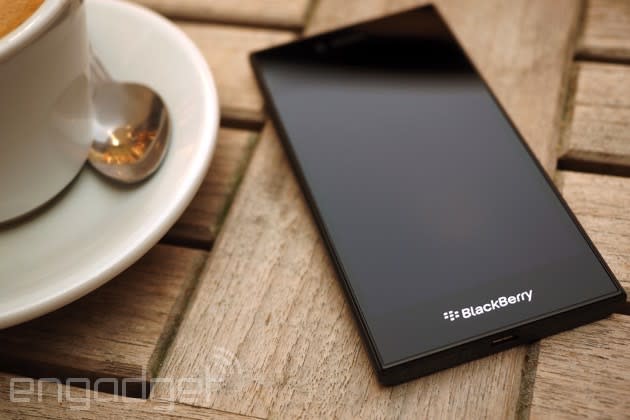
Viewed in isolation, the BlackBerry Leap isn't a terrible device; there's just nothing particularly exciting about it. The design is unimaginative, largely borrowed from the lesser-known BlackBerry Z3, and its size can make it cumbersome to use at times. And, for every positive note, there's always a "but." You wouldn't expect any better or worse than a 720p display on this tier of device, but the quality of the Leap's panel is poor. BB10 OS has some great features, especially the Hub, but a weak app catalog makes it hard to recommend over other platforms. Device performance is admirable, but that doesn't excuse the use of outdated hardware at this price point. The Leap's 8-megapixel main camera is surprisingly good considering the spec, and you gotta love that battery life, but are these enough to warrant a purchase? Perhaps I'm belaboring the point.
If you're a BlackBerry diehard, then you might be willing to forgive the Leap's shortcomings if you're ready to update (I use the term loosely), and it's not extortionately priced at $275/£200. In my opinion, though, you would be compromising where you needn't be. Pick out an affordable Android phone, or simply go for a cheaper BlackBerry if you must. I've been quite happy using the device for the purpose of this review. Like I said from the get-go, if your company gives you one for work purposes, most of my criticisms will be moot. Where productivity is paramount, the Leap shines. If you want a smartphone for your own personal needs, however, then there are better phones and better platforms for the job.















































